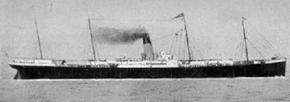
S13725
RICHARDSON, William
| Service Number: | 6148 |
|---|---|
| Enlisted: | 12 September 1916 |
| Last Rank: | Private |
| Last Unit: | 27th Infantry Battalion |
| Born: | Port Lincoln, South Australia, Australia, 25 June 1880 |
| Home Town: | Port Lincoln, Port Lincoln, South Australia |
| Schooling: | Not yet discovered |
| Occupation: | Blacksmith |
| Died: | 12 September 1950, aged 70 years, cause of death not yet discovered, place of death not yet discovered |
| Cemetery: |
West Terrace Cemetery (AIF Section) AIF Cemetery (Row 7, Grave No. 33), West Terrace, Adelaide, South Australia |
| Memorials: |
World War 1 Service
| 12 Sep 1916: | Enlisted AIF WW1, Private, 6148 | |
|---|---|---|
| 6 Nov 1916: | Involvement Private, 6148, 27th Infantry Battalion, --- :embarkation_roll: roll_number: '15' embarkation_place: Adelaide embarkation_ship: HMAT Afric embarkation_ship_number: A19 public_note: '' | |
| 6 Nov 1916: | Embarked Private, 6148, 27th Infantry Battalion, HMAT Afric, Adelaide |
Help us honour William Richardson's service by contributing information, stories, and images so that they can be preserved for future generations.
Add my storyBiography contributed by St Ignatius' College
Before the War:
William Richardson was born on the 25th of June 1880 in the country town of Port Lincoln, South Australia. His mother was Mary Richardson who eventually resided at Vernon St, Norwood, South Australia, and his father was Peter Power whose residence is unknown. Richardson followed the religion of the Church of England which is Anglican. Prior to enlisting to go to war, Richardson was a single man who worked as a blacksmith, shaping iron and metal into various shapes and tools.
Enlisting to go to War:
William Richardson was thirty-seven years and three months old when he enlisted to go to war on the 16th of September 1916. He was five foot three and three quarter inches tall, weighed one hundred and thirty pounds, had a dark complexion to matched his dark eyes and hair which was starting to go grey.
There is no evidence of his reasons for enlisting, however at the start of 1916, conscription was being debated over in parliament. The conscription that was being debated at the time was going to be to force men who were single, without children, and between the age of 20 and 44 to enlist in the armed services. Therefore, some of his enlistment choices could have been influenced by the debate going on in parliament.
Richardson embarked on his transport, a ship named the His Majesty’s Australian Transport (HMAT) “Afric”, on the 11th of November 1916, the same year in which he enlisted.
During the War:
William Richardson was a soldier in the 27th Battalion as a 17th Reinforcement and was grouped in Australia’s 3rd Division. The ship that he embarked on sailed from Australia and arrived in England in July 1916. Upon arriving in England, Richardson commenced training along with the other reinforcements for the 27th Battalion.
Richardson arrived in France during November 1916 and fought in both Belgium and France. Richardson was ranked as a private which was the lowest rank in the Army and he fought in the front line on the Western Front.
During the battles on the Western Front, Richardson was wounded on several occasions. On the 25th of October 1917, his wounds were severe enough for him to be advised to hospital. On the second occasion that Richardson was wounded, which was on the 6th of June 1918, he was able to remain on duty. It was on the 30th of July in 1918, the 27th Battalion came under attack by the Germans who used poisonous gas. Richardson was advised to hospital due to gas poisoning. He was finally advised to return to Australia on the 16th of March in 1919 as a result of the number of wounds he sustained and his lack of ability to fight due to them. Richardson then returned to Australia on the ship, HMAT “Orca” later in 1919.
Life After the War:
In the time between returning from the war until when he died, he was married twice and had a total of five children. Richardson died on the 12th of September in 1950 at seventy years of age. After he died, his wife Elsie May Richardson wrote a note to the Australian Imperial Forces (AIF) enquiring about receiving the service medals that Richardson was unable to. In total, Richardson was awarded two medals for his war service; the Victory medal for his services in 1918 and the British War Medal for his services in 1919.











